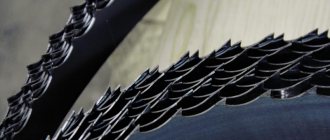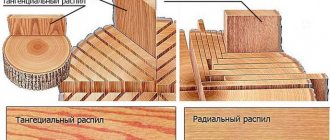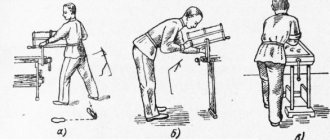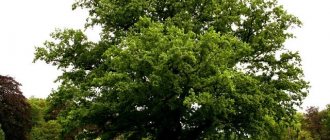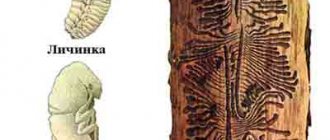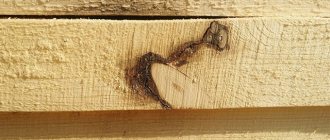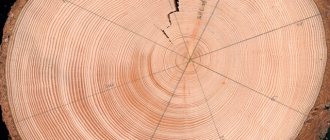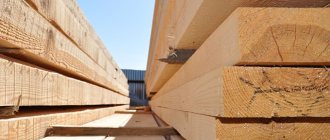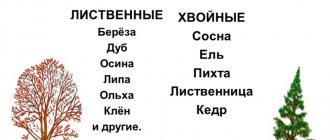Materials Science: Lecture Notes
4. Fungal infections
When cutting wood, in some cases, mushroom core stains
- abnormally colored areas of the kernel that are formed in growing trees under the influence of wood-staining or wood-destroying fungi. In felled wood, further development of this defect stops. Fungal core spots are observed on the ends in the form of spots of various sizes and shapes of brown, reddish-gray or gray-violet colors. This defect causes: a decrease in impact strength, an increase in water absorption and permeability, a deterioration in the biostability and appearance of wood; the strength under static load remains almost unchanged, and the structure of the affected wood is preserved.
When wood is stored on damp sapwood, mold often appears - mycelium and the fruiting of mold fungi on the surface of the wood in the form of separate spots or a continuous coating, and the wood is painted in different colors. Mold does not affect the mechanical properties, but deteriorates the appearance of the wood; after drying, it is easily removed, leaving dirty and colored spots.
Sapwood fungal stains often form in felled wood
- abnormally colored areas of sapwood under the influence of wood-destroying fungi that do not cause the formation of rot. Sapwood mushroom stains do not affect the mechanical properties of wood, but worsen its appearance and increase water resistance. By color, blue is distinguished - in the form of a gray color of sapwood with bluish or greenish tints and colored sapwood spots - in the form of orange, yellow, pink and brown color of sapwood. Fungi that stain sapwood can destroy glue and paint finishes.
In felled wood, when stored in the warm season, as a result of the development of biochemical processes with or without the participation of fungi, a defect such as browning occurs.
Browning of wood appears in the form of abnormally colored areas of hardwood of various shades of brown. Browning is observed on the ends in the form of spots of various sizes and shapes, and on the side surfaces - in the form of elongated spots, stripes or complete damage to the sapwood, while the appearance of the wood deteriorates and the strength and hardness are slightly reduced. To prevent browning of wood, lumber is steamed.
Rot causes great damage to wood
formed under the influence of fungi. Rot is distinguished by the color and structure of the lesion - variegated sieve, white fibrous; and also by type - sapwood, soundwood and external rotten.
Wood affected by rot is a source of fungal infection for various wooden structures. Rot
develops gradually and has three stages: in the first, only the color of the wood changes; on the second, the wood partially changes structure and hardness under the influence of rot; on the third, the wood completely loses its strength and hardness. Depending on the stage of development of the rot and the size of the lesion, the quality of the wood can significantly decrease.
The influence of wood defects on wood quality
Defects and quality of wood are interrelated. All wood defects worsen the appearance of the product. But not all of them violate the structure and reduce the strength characteristics. It is important to understand how certain wood defects affect the quality of products.
If knotty wood is observed, then you need to pay attention to the quality of the knots. Rotten elements negatively affect the properties of the material. A large number of such defects can cause complete rejection of the lumber product.
Biological defects and damage to wooden structures often render products unsuitable for use. GOST prohibits the use of sawn products severely affected by fungi and insects.
Here are the defects of wood that make it difficult to process:
- the presence of sand, stones and other inclusions;
- knots;
- fiber inclination.
All permissible defects of lumber are given in GOST standards. In such documents you can see defects in lining, boards and bars.
How are vices different from defects?
Some people think that vices and defects are synonyms. But the meaning of these terms is different. You need to understand the difference between defects and wood defects.
Wood defects
– these are natural, natural damages that occur under growing conditions (with deterioration of climate, soil composition), as well as during operation and storage. Tree defects disrupt the integrity and uniformity of lumber products. They reduce strength characteristics. Also, defects in lumber make it difficult to process.
There are primary and secondary wood defects. Primary ones are formed during the growth and development of the tree, and secondary ones are formed during the processing of the product.
Wood defects
– these are various mechanical damages of artificial origin. They are formed as a result of the impact of various mechanisms and tools on the product during processing, sorting, procurement, and transportation. Defects in lumber reduce their quality.
Defects of wood.
Wood defects
- these are specific properties and defects of wood that impair its grade and limit economic use.
Natural vices
appear when the tree matures due to deterioration of growth conditions (climate, soil), accidental defects, natural wilting, as well as the activity of microbes and bacteria, wood-boring beetles and birds.
When determining the quality of wooden assortments, the following defect characteristics are taken into account:
- Type
- Size and extent of lesion
- Placement on logs or round timber
Based on the characteristics of the defect, it may not be taken into account, as well as reduce or increase the quality of the material (desirable defects that are used in decorating wooden products).
Unconditional defects are considered to be those defects that significantly reduce the strength of the wood (rotting, large cracks, violation of the integrity of the trunk when colliding with foreign objects or breaking off, etc.).
To determine the type and degree of manifestation of a defect, along with visual inspection, electrical, magnetic and sound flaw detection techniques are used.
TYPES OF DEFECTS
Defects are classified based on the international ISO standard and the current GOST 2140-81.
NATURAL DEFECTS
This category includes knots and wood structure defects (in total, the state standard provides for more than 180 types of natural wood defects).
Bitches
knot
- This is a fragment of a branch enclosed in stem woody tissue. Based on their structure, condition and position relative to the trunk, light and dark knots are distinguished, not completely fused, not fused, and fused. Separate categories are tobacco, loose and falling knots.
Overgrown knots on round timber form characteristic bumps.
Knots are detected in wood of any grade. They significantly affect the quality and possible areas of use of lumber. During sawing and drying, the knots are separated from the surrounding wood, creating holes.
A healthy knot A defective knot A group knot
CRACKS OF FELL-AWNED WOOD
Cracks
- this is a transverse or longitudinal tear of wood tissue relative to the direction of the fibers. In small parts they are assessed as one defect. There are several types of cracks in large lumber.
Shrinkage cracks.
Superficial tears in wood that extend deep into the timber. Occurs during drying. Increases the likelihood of infection by fungi.
Sawing cracks.
A consequence of internal stresses in lumber that occur during sawing.
Steaming and impregnation cracks.
A consequence of a decrease in the strength of parts combined with an increase in internal stresses.
Frost crack Shrinkage crack
Metik
- a radial break in the wood inside the trunk that appears in the heartwood during growth and does not reach the outer layers.
The following types of metics are distinguished:
- Shilfer
- a lot of metics inside the trunk. - Anemone
is an internal crack that widens between the core and outer layers of wood, rather than in the central part of the trunk. - Shooting
is a gap between the annual layers formed in the middle of the trunk. On the end section it appears as an arc-shaped void. - Frostbite
is a defect in a growing tree that appears due to a strong and rapid decrease in temperature. According to the accepted standardization, frost cracks include a thunderbolt - a crack that appeared due to a lightning strike. - A compression crack
is a stem damage to a growing tree that occurs due to excess pressure. - A flake
is a through lateral break in the trunk that extends from the end section. - Shrinkage crack
is an external crack that appears during drying and penetrates into the wood assortment.
A separate category includes cracks that occurred during sawing, steaming and drying of wood.
PROCESSING DEFECTS
This category includes wood defects that arose due to mechanical damage during felling, transportation or cutting of wood.
Foreign inclusion
- a foreign body in a tree (glass, iron fragment, piece of stone, etc.). Forms a swelling on the bark. Complicates material processing and can lead to equipment failure.
Mechanical damage to the barrel
Peeling the bark
- part of the assortment without bark. Under natural conditions, it occurs due to damage to wood by rodents or ungulates. It is an indirect cause of tree infection by fungi or parasites.
Varieties:
- Bark burn
is a violation of the integrity of the bark due to sudden spring warming or as a result of a forest fire. - Oshmyg
- damage or removal of part of the bark when surrounding trees fall during a hurricane or industrial felling. Facilitates the penetration of parasites and fungal spores into the trunk, weakens the tree and can cause drying out.
Charring
- severely burnt areas of the bark.
Carra
— violation of the trunk integrity (tarred area) at the site of cuttings for obtaining resin from coniferous trees. This defect facilitates the penetration of fungal spores into a living tree or into prepared materials.
Zarub
— local defect in the surface of the assortment after damage by an axe.
Makes the material vulnerable to fungal infection and increases the volume of waste. A type of notch is a notch
- a flat damage to the trunk that captures the bark and outer layers of sapwood.
Gash
— local defect of the trunk after processing with tools during harvesting (saw, winch, etc.).
flake
- a penetrating crack that extends from the end part of the assortment, gradually narrowing.
Skol
- the end part of the trunk with missing wood, which broke off during harvesting.
Breakout
- a recess on a part (up to the absence of part of it) with a ribbed, uneven bottom. Appears when exposed to a special instrument (puncture).
On stake
— local damage to assortments with a sharp instrument (hook). It has the form of holes up to 2 cm deep (or through holes for veneer). Reduces the quality of the material, worsens the decorative properties of products and can become an indirect cause of fungal damage.
Bummer
- uneven end from breaking the trunk (for example, during strong winds).
DEFECTS IN WOOD PROCESSING
Sawing defects
Obzol
- bark from the surface of the trunk that remains on the edge of the lumber. Reduces the useful yield of materials, limits the scope of application of the resulting parts.
Obzol
Risks
- a series of marks on lumber from cutting tools after sawing, planing or milling.
Waviness
- depressions and elevations in lumber that have arisen due to bevel sawing or improper drying.
Hairiness
- protruding unseparated fibers on the flat edges of lumber, which make it rough. Occurs when sawing with non-sharpened tools, errors in sharpening/spreading saw teeth, insufficient tension of the saw blade (wandering sawing), etc.
Mossiness
- a large amount of pile and a lot of unseparated wood fibers on the flat edges of the lumber.
Fringe
- a continuous or torn strip of many unseparated fibers on the edges of a board or beam. Occurs during sawing in the warm season, when processing cross-grained, twisted or knotted wood, or due to irregularities in setting up and using woodworking tools.
Other processing defects
Bevel cut
- beveled plane of cut on round timber.
Torn end
- ribbed recesses and elevations, as well as tufts and fibers on the end plane.
Visor
- wood extending beyond the end plane, resulting from incomplete sawing of the assortment.
Zakorina
- part of the bark that is preserved on the veneer (may fall out, leaving holes and grooves).
Burr
- a pointed protrusion that is adjacent to the edge of the lumber.
Badass
- a piece of wood with sharp edges that has not come off after planing.
Gouges
— shallow recesses in places where pieces of fibers are torn off.
Rippling Veneer
- densely placed shallow grooves parallel to the longitudinal axis of the fibers.
Dent
- a notch in lumber that occurs due to local deformation when struck with a sledgehammer (or other tool) and when the tree is felled.
Scratch
- a mark on lumber (indentation) after contact with a sharp object.
Snatch
- a recess across the entire width of the processing surface, which occurred when part of the assortment was removed during milling or processing with an electric planer below the calculated level.
Non-milling
- unprocessed area of the part.
Scallop
- an unprocessed area of lumber that rises above the milled part (a consequence of incorrect cutter settings).
Sanding
— cutting the assortment below the required level during grinding.
Under-grinding
- untreated area of the surface of the assortment, which has already been ground.
Burn
- a blackened zone on the surface of the log, which appeared when the moving parts of a woodworking tool rubbed against the wood.
DISRUPTIONS
Warped
— deformation of edged lumber during sawing, drying or storage.
Warping during drying occurs due to the difference in drying of the material in tangential and radial orientation. Warping may be an indirect sign of another defect: cross-layers, heels, knots, etc. During drying, sapwood areas lose moisture faster. Their volume decreases faster than parts of the part consisting of wood that was closer to the core, so it bends towards the sapwood. The degree of manifestation of the defect changes with changes in wood moisture content.
Warping may be a consequence of residual stress in the wood during sawing (manifests itself during milling and sawing of the board).
This defect complicates the use of lumber. At a high degree of manifestation it leads to complete unusability of parts. It complicates harvesting and reduces the yield of useful wood.
To prevent warping, the boards are dried compressed in accordance with a specially selected regime, which does not lead to the appearance of strong stresses inside the part. The remaining stress is removed using additional heat and moisture treatment.
The possibility of warping is taken into account when gluing wooden parts.
Warp measurement
- Longitudinal warping
- measured by the ratio of the longest arrow of deflection and the length of warping (expressed as a percentage). - Transverse warpage
- measured by the ratio of the maximum deflection and the width of the lumber (expressed as a percentage). - Winginess
- measured by the maximum deviation of the surface of the part from the required plane.
Warping of laminated plywood is measured using a ruler, which is applied to the sheet diagonally (expressed in centimeters in relation to 1 linear meter of diagonal length).
Types of warping
- Longitudinal (along the layer).
The boards are bent towards a wide plane. There are simple longitudinal (1 bend) and complex longitudinal (more than 1 bend) warping. - Longitudinal along the edge.
Folding the board towards the edge. - Transverse.
Deformation of the material in the cross section, which depends on the place where the part is cut: the edges of the boards are bent towards the sapwood; the cross-section of the bars, in which the annual layers are located diagonally, takes the shape of a rhombus; For lumber that is cut from heartwood, the edges taper and become thinner than the central part of the piece. - Winging (helical warping).
Spiral warping along the length of the lumber. Occurs during accelerated drying due to different rates of moisture release in different parts of the part. Winging is the name given to the torsion of round timber, which is a consequence of another defect (for example, cross-grain).
